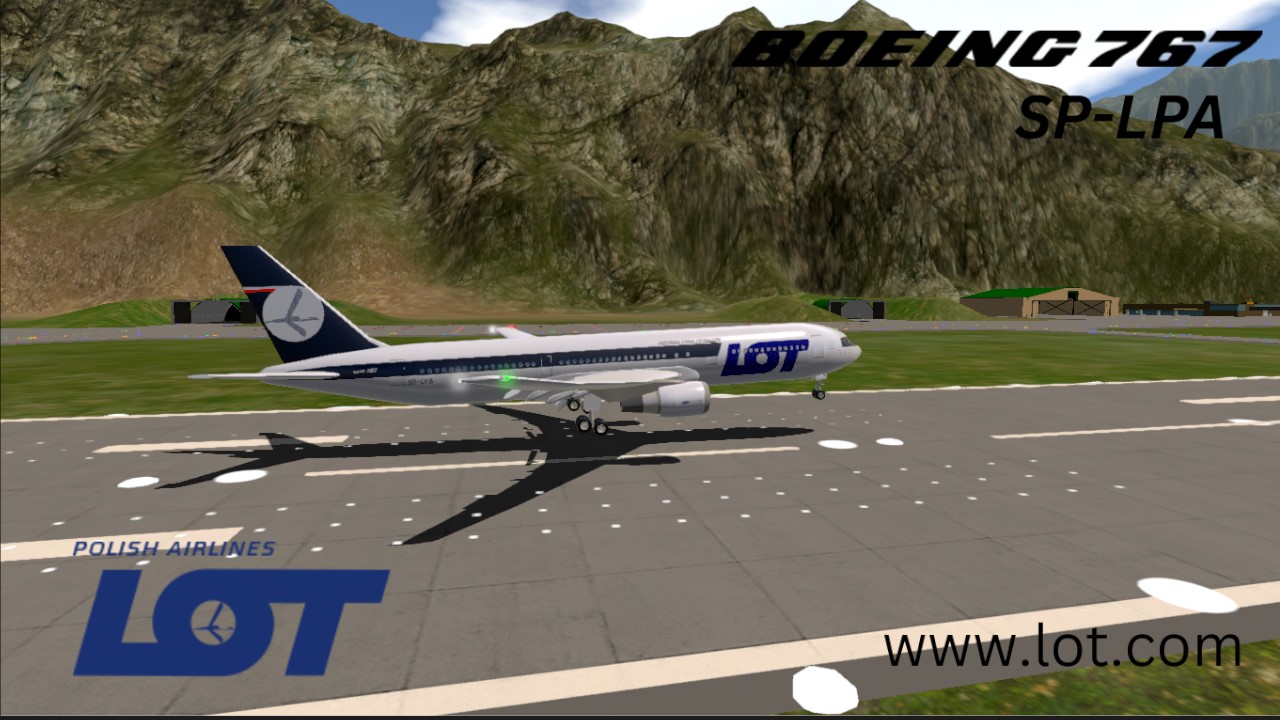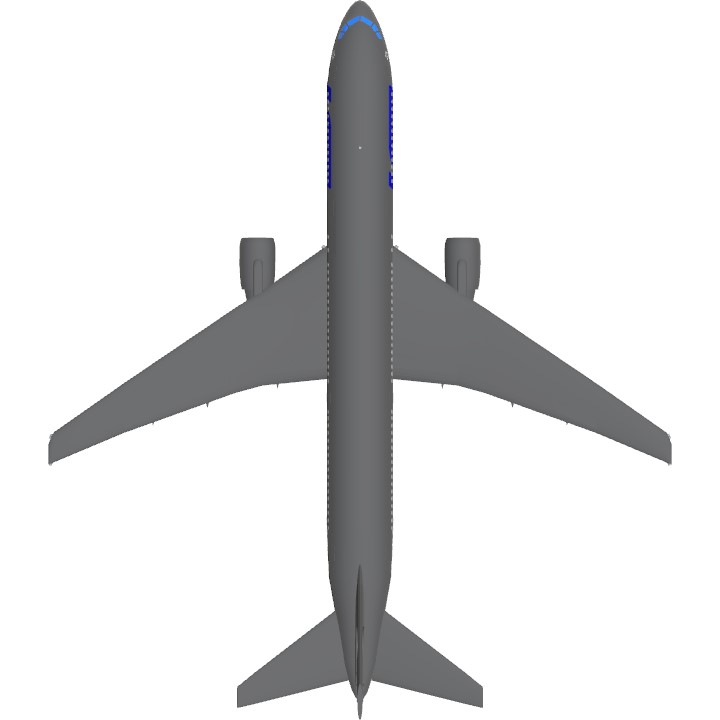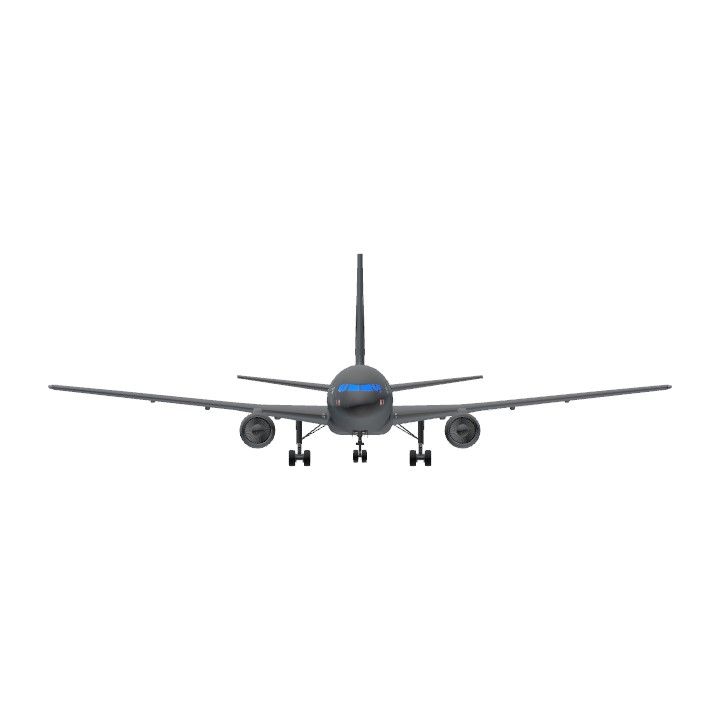Ahh

About Boeing 767
The Boeing 767 is an American wide-body airliner developed and manufactured by Boeing Commercial Airplanes. The aircraft was launched as the 7X7 program on July 14, 1978, the prototype first flew on September 26, 1981, and it was certified on July 30, 1982. The initial 767-200 variant entered service on September 8, 1982, with United Airlines, and the extended-range 767-200ER in 1984. It was stretched into the 767-300 in October 1986, followed by the extended-range 767-300ER in 1988, the most popular variant. The 767-300F, a production freighter version, debuted in October 1995. It was stretched again into the 767-400ER from September 2000.
Designed to complement the larger 747, it has a seven-abreast cross-section accommodating smaller LD2 ULD cargo containers. The 767 is Boeing's first wide-body twinjet, powered by General Electric CF6, Rolls-Royce RB211, or Pratt & Whitney JT9D turbofans. JT9D engines were eventually replaced by PW4000 engines. The aircraft has a conventional tail and a supercritical wing for reduced aerodynamic drag. Its two-crew glass cockpit, a first for a Boeing airliner, was developed jointly for the 757 − a narrow-body aircraft, allowing a common pilot type rating. Studies for a higher-capacity 767 in 1986 led Boeing to develop the larger 777 twinjet, introduced in June 1995.
The 159-foot-long (48.5 m) 767-200 typically seats 216 passengers over 3,900 nautical miles [nmi] (7,200 km; 4,500 mi), while the 767-200ER seats 181 over a 6,590 nmi (12,200 km; 7,580 mi) range. The 180-foot-long (54.9 m) 767-300 typically seats 269 passengers over 3,900 nmi (7,200 km; 4,500 mi), while the 767-300ER seats 218 over 5,980 nmi (11,070 km; 6,880 mi). The 767-300F can haul 116,000 lb (52.7 t) over 3,225 nmi (6,025 km; 3,711 mi), and the 201.3-foot-long (61.37 m) 767-400ER typically seats 245 passengers over 5,625 nmi (10,415 km; 6,473 mi). Military derivatives include the E-767 for surveillance and the KC-767 and KC-46 aerial tankers.
Initially marketed for transcontinental routes, a loosening of ETOPS rules starting in 1985 allowed the aircraft to operate transatlantic flights. A total of 742 of these aircraft were in service in July 2018, with Delta Air Lines being the largest operator with 77 aircraft in its fleet. As of June 2025, Boeing has received 1,430 orders from 74 customers, of which 1,335 airplanes have been delivered, while the remaining orders are for cargo or tanker variants. Competitors have included the Airbus A300, A310, and A330-200. Its successor, the 787 Dreamliner, entered service in 2011.

A Delta Air Lines 767-300

An All Nippon Airways 767-300ER
About 767-300ER
The 767-300ER, the extended-range version of the 767-300, entered service with American Airlines in 1988. The type's increased range was made possible by greater fuel tankage and a higher MTOW of 407,000 lb (185,000 kg). Design improvements allowed the available MTOW to increase to 412,000 lb (187,000 kg) by 1993. Power is provided by Pratt & Whitney PW4000, General Electric CF6, or Rolls-Royce RB211 engines. The 767-300ER comes in three exit configurations: the baseline configuration has four main cabin doors and four over-wing window exits, the second configuration has six main cabin doors and two over-wing window exits; and the third configuration has six main cabin doors, as well as two smaller doors that are located behind the wings. Typical routes for the type include New York to Frankfurt.
The combination of increased capacity and range for the -300ER has been particularly attractive to both new and existing 767 operators. It is the most successful 767 version, with more orders placed than all other variants combined. As of November 2017, 767-300ER deliveries stand at 583 with no unfilled orders. There were 376 examples in service as of July 2018. The type's main competitor is the Airbus A330-200. At its 1990s peak, a new 767-300ER was valued at $85 million, dipping to around $12 million in 2018 for a 1996 build.

A WestJet 767-300ER equipped with winglets
About LOT Polish Airlines

LOT Polish Airlines, legally Polskie Linie Lotnicze LOT S.A. (Polish pronunciation: [lɔt], flight), is the flag carrier of Poland. A founding member of IATA, it is one of the world's oldest airlines. With a fleet of 87 aircraft as of June 2025, LOT is Europe's 16th largest operator, serving 97 destinations across Europe, Asia and North America. The airline was founded on 29 December 1928 by the Polish government during the Second Polish Republic as a self-governing limited liability corporation, taking over existing domestic airlines Aerolot (founded in 1922) and Aero (founded in 1925). LOT officially commenced operations on 1 January 1929.
In the 1930s, LOT expanded its domestic and international routes, leading to a network spanning over 10,250 km by 1939. It also expanded its fleet, acquiring Douglas DC-2 and Lockheed Electra aircraft, amongst others. The airline moved its operations to the new Warsaw Okęcie Airport in 1934. However, the outbreak of World War II in 1939, led to the suspension of services and the evacuation of most of LOT's aircraft. Post-war, LOT was reestablished in 1945 as a state enterprise, primarily operating Soviet aircraft due to Poland's reemergence as communist state in 1948. Resuming both domestic and international flights, LOT operated a fleet consisting of Ilyushin Il-18, Ilyushin Il-62, Tupolev Tu-134 and Antonov An-24 aircraft. LOT served routes across Europe, the Middle East, and eventually launched transatlantic flights in the early 1970s.
In the post-1989 era, following the fall of communism in Poland, LOT transitioned to Western aircraft, including the Boeing 767 for long-haul routes. The airline joined the Star Alliance in 2003. In 2012, LOT became the first European operator of Boeing 787 Dreamliner. In recent years, the airline faced a failed privatisation attempt and a temporary suspension of operations due to the COVID-19 pandemic. Most of LOT's destinations originate from its hub at Warsaw Chopin Airport. Between 2019 and 2025, LOT maintained a year-round, long-haul route connecting Budapest Ferenc Liszt International Airport to Seoul Incheon International Airport. The airline discontinued this service in March 2025.

An LOT B787-8
History of SP-LPA
HERE because it is too long
Credit
GalacticaAsia for the plen
To wszystko, ciesz się!

Specifications
Spotlights
- BluesynVN 3 months ago
General Characteristics
- Predecessor B767-300ER LOT
- Created On Windows
- Wingspan 156.2ft (47.6m)
- Length 180.3ft (55.0m)
- Height 53.2ft (16.2m)
- Empty Weight N/A
- Loaded Weight 94,720lbs (42,964kg)
Performance
- Power/Weight Ratio 0.616
- Horse Power/Weight Ratio 0.031
- Wing Loading 24.5lbs/ft2 (119.6kg/m2)
- Wing Area 3,866.8ft2 (359.2m2)
- Drag Points 19517
Parts
- Number of Parts 549
- Control Surfaces 9
- Performance Cost 3,355






HELP ME GET GOLD
Wait until I'll change the registration number to SP-LPC. LOT flight 16 vibes duh.
@KLM747x9rtyt halo good livery
@Mitterbin hello
if you take requests can you do a comair 727 chatham dockyard
@Dreamlinerboi never
good